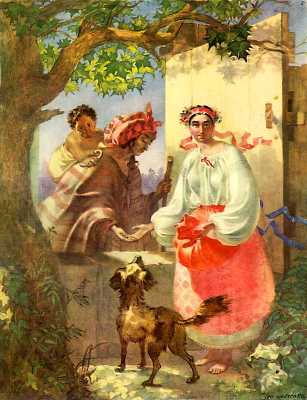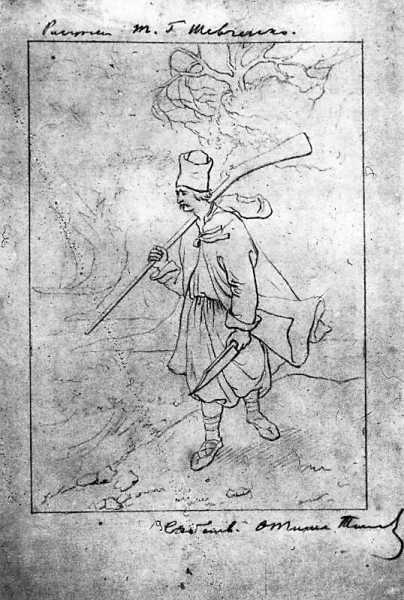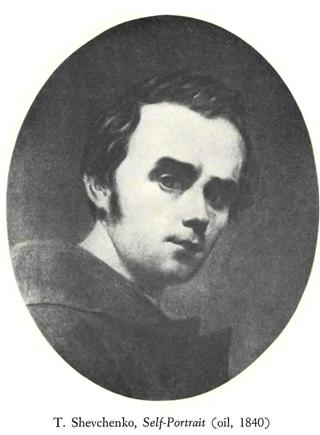TARAS SHEVCHENKO’S LIFE AND WORK
Taras Shevchenko's evolution as a national poet of Ukraine
(The part of Shevchenko's life story, by C.H. Andrusyshen)
(Introduction of "The poetical works of Taras Shevchenko. The Kobzar" by Constantine Henry Andrusyshen and Watson Kirkconnell)
The life he led after his emancipation was a lively one, quite in contrast with the previous desperate existence that even a few short days before he attained freedom had brought him to the brink of suicide. But pleasurable living, however unconfined at times, was mixed with serious labour. He continued to pursue his artistic vocation and simultaneously fill in the wide gaps in his education by intensive reading begun in his Shiryayev period. The following is a partial list of the items he read: History of Ancient Greece by John Gillis, The Journey of Anacharsis by Abbe Barthelemy, Plutarch's Lives, Michauds History of the Crusades, Dante's Inferno, Goldsmith, Byron, Richardson, Macpherson, Shakespeare, Defoe, Walter Scott, Dickens, J.-J. Rousseau, Chateaubriand, Hugo, Sue, Goethe, Schiller, Heine, Korner, Washington Irving, Mickiewicz, Krasinski, and other Polish authors, practically all the Russian classics, and whatever journals on the aesthetic arts were available to him. In addition, he often attended lectures in physics, zoology, and anatomy delivered by his professor friends at the University.
Shortly before his emancipation, and particularly directly following it, Shevchenko's predominance as a poet became quite marked, in spite of his continued cultivation of a career in painting. He began as a strict romanticist with the ballad “The Bewitched Woman" (Przchinna') which he wrote in 1837. The next year proved prolific in shorter lyrics and longer poems, twelve items in all, written under the influence of the social conditions either of his day or of the Cossack historical past.
The encouragement and impetus to their publication was supplied by P. Martos, a wealthy Ukrainian landlord from the Poltava region, whose portrait Shevchenko was painting at that time. The story goes that one day, as he was posing, for want of something to do Martos picked up from the table a sheet of paper on which a part of the poem “The Night of Taras" (Tarasova Nitch) appeared. So taken up was he with its verbal impact and vivid phraseology that he immediately proposed that all the poems that Shevchenko kept in a box under his bed be published in a collection. The poet agreed, and the brief volume under the title of The Kobzar (The Minstrel, lit. The Kobza Player) appeared in print in the early days of April 1840. It was illustrated by the author's close friend, Sternberg, who happened to be sharing Shevchenko's living quarters that year.

Taras Shevchenko,
"Gypsy fortune-teller, 1841."Besides two highly fantastical ballads in the Romantic vein and several subjective lyrics, The Kohzar contained a long poem “Katerina” dealing with the social theme of a young mother out of wedlock. Its subject was borrowed from the Russian poem, “Bednaya Liza,” by N. M. Karamzin, hut Shevchenko made it his own by giving it a thoroughly Ukrainian setting and colouring. In “To the Eternal Memory of Ivan Kotliarevsky,” Shevchenko revealed the powerful role the poet plays in the spiritual life of his people, an idea that he intensified in another poem, “Perebendia.” In the poems “The Night of Taras,” “Ivan Pidkova,” and “To Osnovianenko,” in which he romantically idealized the Cossack past, are strongly evident the influences exerted on him by the historical works of D. BantishKamensky and H. Poletika and particularly by I. Sreznevsky’s Zaporozhskaya Starina (The Zaporozhian Antiquities). The imprint of these works upon Shevchenko’s sensitively receptive soul proved indelible and marked out the poetic course that he was to follow throughout his life.
The acclaim this brief collection of verse received from his immediate friends and presently from all Ukrainians was immense. It roused the entire nation to an enthusiasm that knew no bounds, for never before in the history of the Ukrainian people had any poet described the vicissitudes of the Ukrainian historical, particularly its Cossack, past in such glowing and exalted terms, or written about it with such patriotic fervour. The Kohzar was like a trumpet’s clarion sound proclaiming the existence of the Ukrainian nation. For that reason Shevchenko was at once and unequivocally accepted as its chief spokesman.
As regards academic criticism, the outcome was altogether different. Most of the Russian critics took a negative, in fact, a destructive stand with respect to The Kobzar. While not denying that Shevchenko possessed genuine poetic gifts, they (particularly one Senkovsky) attacked him fiercely for writing in a peasant “dialect,” thus depriving Russian literature of a distinct contribution on the part of so great a talent. Others judged its “monstrous” language as a hterary joke, a parody, and prophesied for it a bleak fortune in the state archives, if it even got there. Already in his “To Osnovianenko” Shevchenko had anticipated this sort of reaction and braced himself agamst it. His intransigent answer, however, came in the poetized preface to his longest poem, The Haydamaks, in which he in no uncertain terms rejected the judgments of those who maintained that the Ukrainian language could not be employed as a vehicle for poetic
expression, and that it was ridiculous to claim for that “dead” speech more than a plebeian function. To those who advised him that, if he desired fame and money, he should write not in “moribund” phrases about ragged, illiterate people, but on subjects dealing with high society (such as were then treated in Russian literature), and in the Russian language, Shevchenko replied categorically, using a popular saying: “The sheepskin coat is warm, but not made to my measure.” Proudly asserting himself as the best judge of the instrument at his command, he in turn ridiculed his critics and affirmed that as long as he himself experienced pleasure and satisfaction from the subjects he dealt with, lowly as they were, nothing else mattered; and, that being the case, the “dead” idiom was good enough for him. The more caustic the criticism in that respect, the more determined Shevchenko became to write in Ukrainian, and even encouraged other Ukrainian writers to endure in the use of their native tongue.
His greatest opponent was the chief ’ Russian critic, Vissarion Belinsky, who was an inveterate enemy of all those who “foolishly wasted” their talents and powers in scribbling Ukrainian (in his terminology — Little Russian) for some benighted southern peasants. It is to be noted that Belinsky, who based his first criticism on certain poems by Shevchenko published in the journal Lastivka (previous to their inclusion in The Kohzar), did not trouble himself with even remotely attempting to give an evaluation of their poetic worth, but directed his  attack against the language itself. Understanding it but poorly, he simply and peremptorily declared that he could not find any worthwhile values in the poems. It was therefore mainly at Belinsky that Shevchenko's emphatic reply at the beginning of The Haydamaks was directed. Roused by Shevchenko's reaction, Belinsky continued to pester the poet for the next year or so, not only scoffing at the various episodes in The Haydamaks (published in 1841) but denying that he possessed any poetic gift at all, and advising him to abandon poetry altogether to write popular brochures on ordinary social topics dealing with the problems of the “Little Russian” peasantry. Although Belinsky was indisputably a first rate critic in literary aestheticism, in this case he lapsed into a petty, wrangling individual, venting his gall in cruel invective unworthy of his otherwise exceptional talent.
attack against the language itself. Understanding it but poorly, he simply and peremptorily declared that he could not find any worthwhile values in the poems. It was therefore mainly at Belinsky that Shevchenko's emphatic reply at the beginning of The Haydamaks was directed. Roused by Shevchenko's reaction, Belinsky continued to pester the poet for the next year or so, not only scoffing at the various episodes in The Haydamaks (published in 1841) but denying that he possessed any poetic gift at all, and advising him to abandon poetry altogether to write popular brochures on ordinary social topics dealing with the problems of the “Little Russian” peasantry. Although Belinsky was indisputably a first rate critic in literary aestheticism, in this case he lapsed into a petty, wrangling individual, venting his gall in cruel invective unworthy of his otherwise exceptional talent.
For the next three years Shevchenko, full of zestful energy, continued to live merrily in the circle of his many friends. His almost bohemian life, however, by no means curtailed either his poetic or his pictorial art, both of which he pursued intensively. For a very short time he wrote in Russian, the result being two plays, one of which, Slepaya (The Blind Woman) he turned into a poem. The other drama Neviesta (The Betrothed) dealt with the age of Hetman Khmelnitsky. With neither, however, was he satisfied, and willy-nilly came to the conclusion that he was destined to write effective verse only in his native tongue if he were to remain true to himself and to the spirit of his race.
Introduction written by Professor C.H. Andrusyshen
Source: The Poetical Works of Taras Shevchenko. The Kobzar. Translated from the Ukrainian by С.H. Andrusyshen and Watson Kirkconnell. Published for the Ukrainian Canadian Committee
by University of Toronto Press, 1964. Toronto and Buffalo. Printed in Canada, Reprinted 1977, p.14 - 17.
Read more:

Introduction of "The poetical works of Taras Shevchenko. The Kobzar" by Constantine Henry Andrusyshen and Watson Kirkconnell.

 attack against the language itself. Understanding it but poorly, he simply and peremptorily declared that he could not find any worthwhile values in the poems. It was therefore mainly at Belinsky that Shevchenko's emphatic reply at the beginning of The Haydamaks was directed. Roused by Shevchenko's reaction, Belinsky continued to pester the poet for the next year or so, not only scoffing at the various episodes in The Haydamaks (published in 1841) but denying that he possessed any poetic gift at all, and advising him to abandon poetry altogether to write popular brochures on ordinary social topics dealing with the problems of the “Little Russian” peasantry. Although Belinsky was indisputably a first rate critic in literary aestheticism, in this case he lapsed into a petty, wrangling individual, venting his gall in cruel invective unworthy of his otherwise exceptional talent.
attack against the language itself. Understanding it but poorly, he simply and peremptorily declared that he could not find any worthwhile values in the poems. It was therefore mainly at Belinsky that Shevchenko's emphatic reply at the beginning of The Haydamaks was directed. Roused by Shevchenko's reaction, Belinsky continued to pester the poet for the next year or so, not only scoffing at the various episodes in The Haydamaks (published in 1841) but denying that he possessed any poetic gift at all, and advising him to abandon poetry altogether to write popular brochures on ordinary social topics dealing with the problems of the “Little Russian” peasantry. Although Belinsky was indisputably a first rate critic in literary aestheticism, in this case he lapsed into a petty, wrangling individual, venting his gall in cruel invective unworthy of his otherwise exceptional talent.